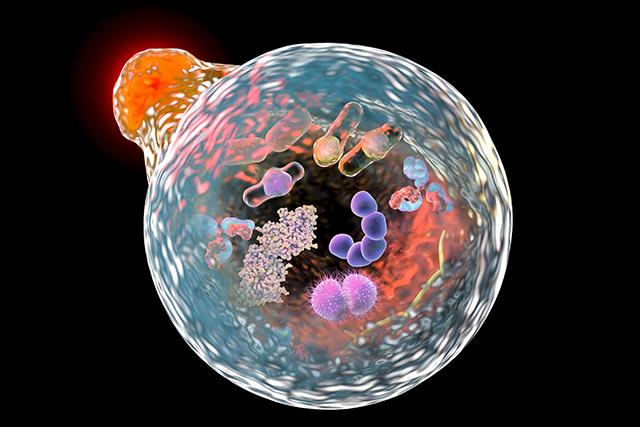Scientists have developed an effective marker for cancer diagnosis and therapy

This is lysosome. Credit: © NUST MISIS
The lack of accuracy (“contrast”) in imaging is a common problem of non-invasive diagnosis. “Contrast agents”, compounds that are introduced into the body before a diagnosis procedure to enhance the response and make affected cells more visible on a tomograph, can be used to solve this problem in magnetic resonance imaging (MRI). Paramagnetic gadolinium particles and superparamagnetic iron particles are among these agents. However, even in small quantities, these substances – alien to the human body – can potentially be dangerous.
“The international research team, including Dr. Ulf Wiedwald, a visiting Professor at the NUST MISIS Biomedical Nanomaterials Laboratory, has developed a unique injection diagnosis system based on magnetoferritin. The developed system will significantly improve the quality of MRIs and optical diagnosis”, — said Alevtina Chernikova, Rector of NUST MISIS.
Magnetoferritin is a compound consisting of endogenous human protein (ferritin) and a magnetic nucleus. The development and testing of the compound was conducted following the existing protocol for the synthesis of magnetoferritin, but was improved for the effective capture of tumor cells. The high concentration of magnetoferritin in tumor tissue made it possible to obtain a hypoallergenic contrast agent that is perfectly compatible with the human body.
“An intravenous injection of magnetoferritin has been proposed. Then, spreading with the blood flow, [the magnetoferritin] will be captured by the targeted tumor cells. As has been shown in a large number of studies, these cells actively capture transferrin – the protein responsible for transport of iron in blood. The same receptors are capable of capturing magnetoferritin as well. Once they get into the lysosomes of targeted cells, the magnetoferritin will further enhance the contrast signal”, — commented Dr. Wiedwald.
The system will also allow doctors to conduct therapy on tumor formations. If cancerous cells are identified, they can be targeted by an electromagnetic field or light, which will lead to their heating and subsequent death.
Media Contact
All latest news from the category: Health and Medicine
This subject area encompasses research and studies in the field of human medicine.
Among the wide-ranging list of topics covered here are anesthesiology, anatomy, surgery, human genetics, hygiene and environmental medicine, internal medicine, neurology, pharmacology, physiology, urology and dental medicine.
Newest articles

Detector for continuously monitoring toxic gases
The material could be made as a thin coating to analyze air quality in industrial or home settings over time. Most systems used to detect toxic gases in industrial or…

On the way for an active agent against hepatitis E
In order to infect an organ, viruses need the help of the host cells. “An effective approach is therefore to identify targets in the host that can be manipulated by…

A second chance for new antibiotic agent
Significant attempts 20 years ago… The study focused on the protein peptide deformylase (PDF). Involved in protein maturation processes in cells, PDF is essential for the survival of bacteria. However,…





















